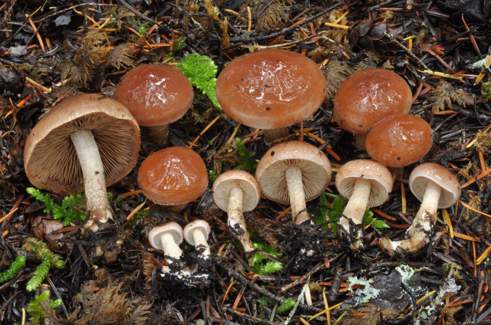 Hebeloma olympianum (Photo: N. Siegel)
Hebeloma olympianum (Photo: N. Siegel)Taxonomy
Full name: Hebeloma olympianum A.H. Sm., V.S. Evenson & Mitchel, The Veiled Species of Hebeloma in the Western United States: 101 (1983)Genus: Hebeloma
Section: Scabrispora
Types: UNITED STATES: Washington: Clallam, Mt Storm King, Olympic National Park (approx. 48.0555°N, 123.7395°W, alt. approx. 1290 m a.s.l.) on soil in woodland pathside, 16 Oct. 1941, A.H. Smith (17972) (Holotype. herbarium acc. no. MICH 10781, HJB1000439).
Heterotypic synonyms:
- Hebeloma aurantiellum A.H. Sm., V.S. Evenson & Mitchel, The Veiled Species of Hebeloma in the Western United States: 97 (1983)
- Hebeloma subhepaticum A.H. Sm., V.S. Evenson & Mitchel, The Veiled Species of Hebeloma in the Western United States: 105 (1983)
- Hebeloma trinidadense A.H. Sm., V.S. Evenson & Mitchel, The Veiled Species of Hebeloma in the Western United States: 107 (1983)
- arrow_drop_downarrow_drop_upEtymology
- arrow_drop_downarrow_drop_upOriginal diagnosisPileus 1-2.5 cm latus, obtusus deinde campanulatus vel planoumbonatus, tenuiter fibrillosus, glabrescens, viscidus, cinnamomeus; odor et gustus mitis. Lamellae pallidae demum brunneolae deinde cinnamomeae, confertae, latae, adnatae. Stipes 2-4 cm longus, 2.5-3.5 mm crassus, tenuiter fibrillosus, glabrescens, deorsum brunnescens. Sporae 7-9 x 4-5.5 μm, minute verruculosae, leviter dextrinoideae, inequilaterales. Cheilocystidia (18) 22-27 x 4-7 μm, + filamentosa vel anguste clavata. Cuticula pileorum ixotrichoderma est.
- arrow_drop_downarrow_drop_upEnglish translationPileus 1-2.5 cm broad, obtuse then campanulate or applanate-umbonate, slightly fibrillose, becoming glabrous, viscid, cinnamon; smell and taste mild. Lamellae pale then brownish, finally cinnamon, crowded, broad, adnate. Stipe 2-4 cm long, 2.5-3.5 mm thick, slightly fibrillose, becoming glabrous, discolouring brown downwards. Spores 7-9 x 4-5.5 μm, faintly verrucose, slightly dextrinoid, inequilateral. Cheilocystidia (18) 22-27 x 4-7 μm, more or less filamentous or narrowly clavate. The pileus cuticle is an ixotrichoderm.
References
Description
- arrow_drop_downarrow_drop_upThresholds
Description of Hebeloma olympianum based on 23 collections
- arrow_drop_downarrow_drop_upMacroscopic descriptionPileus: (9) 16–52 (90) mm diameter; shape usually convex, occasionally umbonate; characters occasionally remains of universal veil; margin characters involute, occasionally smooth, rarely fibrillose; viscosity tacky when moist; colour variation usually unicolour, occasionally two color; colour at centre occasionally orange-brown, yellowish brown or brownish olive, rarely greyish brown or brick.
Lamellae: attachment occasionally emarginate, adnexed or adnate; maximum depth up to 7 mm; number of complete lamellae 36–60; presence of tears absent; white fimbriate edge occasionally absent, weak or present.
Cortina presence: no.
Stipe: (20) 36–77 (100) x (2) 3–7 (11) {median} x (2) 3–7 (12) {basal} mm; stipe Q 5.3–30.0; base shape usually cylindrical, occasionally clavate or tapering, rarely bulbous; floccosity often pruinose at apex or fibrillose, occasionally floccose, rarely velute; rooting variable; thick rhizoids at base often absent, occasionally present;
Context: Texture firm; stipe interior often hollow or stuffed; stipe flesh discolouring often yes, occasionally no, rarely weak; slenderness measure 8.9–80.7; smell often odourless, occasionally earthy, rarely farinaceous or sweet; taste occasionally mild or none, rarely bitter where recorded.
Spore deposit colour: yellowish brown.
Exsiccata characters: pileus blackening or stipe blackening, occasionally lamellae blackening.
- arrow_drop_downarrow_drop_upMicroscopic descriptionSpores: shape amygdaloid, rarely limoniform; colour in microscope brown or yellow brown; guttules yes. papilla usually no, rarely yes; Spore Code: O2 (O3); P1 P2; D3 (D4).
Basidia: (18) 20–34 (39) x (4) 5–7 μm; ave. Q 3.4–5.2; spore arrangement 4 spored;
Cheilocystidia: main shape cylindrical, rarely filiform; special features observed often septa, occasionally many collapsed in exsiccata or short, rarely branching, clamped septa, irregular, rostrate, geniculate or subcapitate; cheilocystidia ratios: A/M = 0.93–1.07; A/B = 0.84–1.13; B/M = 0.92–1.15.
Pleurocystidia: none seen.
Ixocutis: epicutis thickness (measured from exsiccata) up to 200 μm; ixocutis hyphae width up to 6 μm; ixocutis hyphae encrustation yes; shape of trama elements beneath subcutis cylindrical or thickly sausage-shaped, often ellipsoid up to 18 μm wide.
Caulocystidia: Similar to cheilocystidia but larger, up to 90 μm.
- arrow_drop_downarrow_drop_upSpore measurements
- arrow_drop_downarrow_drop_upCheilocystidia measurements
- arrow_drop_downarrow_drop_upHabitat and distributionHebeloma olympianum's preferred habitat appears to be campsite, woodland pathside or shrubland with nutrient-enriched soil, soil or grassy soil. Where only one possible associate was recorded, that associate has always been Picea (family Pinaceae). We have additional records where Pseudotsuga, Notholithocarpus, Quercus, Tsuga, Abies, Arbutus and Pinus were recorded as possible associates, but in these cases a number of possible associates were mentioned. Overall the most commonly recorded families are Pinaceae (100.0%), Fagaceae (47.1%) and Ericaceae (11.8%) The growth habit of our collections was often scattered or gregarious and occasionally caespitose.
According to our current collections, the species is found only in Northern America. On the continent, collections have been found only in the temperate conifer forests WWF biome The World Wildlife Fund (WWF) have divided the world into 867 terrestrial ecoregions. The ecoregion here is estimated by mapping from the GPS coordinates of the collection using data made available by Dinerstein et al (2017). Use this webtool to explore the ecoregions visually or see a full list of current ecoregions on Wikipedia. (Northern California coastal forests (43.5%) and Klamath-Siskiyou forests (39.1%) ecoregions). From collector information, it appears collections have been found in the 1.4 Forest – Temperate (50.0%) and 14.5 Urban Areas (40.0%) IUCN habitats We map from the collector's description of the habitat to the International Union for Conservation of Nature (IUCN)'s definition using a standardised set of rules. Please see this page for a full list of IUCN habitats.. Within Northern America we have records from Southwestern U.S.A. (California), Northwestern U.S.A. (Washington and Oregon) and Western Canada (British Columbia).
Geographic distribution
Phenology
- arrow_drop_downarrow_drop_upAdditional cited collections